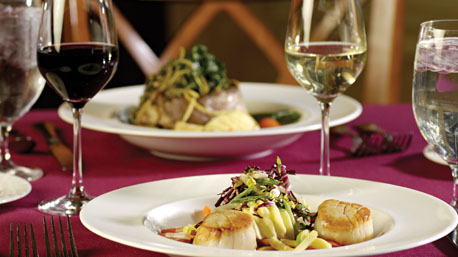The first thing to remember about matching food and wine is to forget the rules.Forget about the do’s and the dont’s. Forget about complicated systems and processes for selecting the right wine to enhance the food on your table. This is not astrophysics, It’s simply common sense. follow your instincts and you can’t go wrong….well most of the time anyway.
Some of today’s food-and-wine connoisseurs suggest that mediocre wines can be improved by serving them with the right food.The flaw in that reasoning,however, is that you will probably drink most of the wine without the benefit of food-either before the food is served or after you’ve finished your meal. If the match does not quite work as well as you hope, you’re stuck with a mediocre wine. So don’t try to get too fancy. First pick a good wine.
This is where common sense comes in. The old rule about white wine with fish and white meats and red wine with red meat made perfect sense in the days when white wines were light and fruity and red wines were tannic and weighty. But today, when most California Chardonnays are heavier and fuller-bodied than most California Pinot Noirs and even some Cabernets,this traditional colour coding does not always work.
Red wines as a category are distinct from whites in two main ways : tannins–many red wines have them, few white wines do–and flavors. White and red wines share many common flavors; both can be spicy, earthy or floral. But the apple, pear, and citrus flavors in many white wines seldom show up in reds, and the currant, cherry flavors of red grapes usually do not appear in whites.
To match wines with food, it’s useful to know where they fit in a spectrum, with the lightest wines at one end and fuller-bodied wines toward the other end.
A Spectrum of Wines
To help put the world of wines into perspective, here is a list, which arranges many of the most commonly encountered wines into hierarchy based on the above, from lightest to weightiest. If you balance the wine with the food by choosing one that will seem about the same weight as the food, you stand a much better chance that the match will succeed.
Selected dry and off-dry White Wines :
-
Soave
-
Off-dry Riesling
-
Dry Riesling
-
Muscadet
-
Champagne and other dry sparkling wines
-
French Chablis and other unsoaked Chardonnays
-
Sauvignon Blanc
-
White Bordeaux
-
White Burgundy
-
Gewurztraminer
-
Barrel-fermented or barrel-aged Chardonnay (United States, Australia)
Selected Red Wines :
-
Valpolicella
-
Beaujolais
-
Rioja
-
California Pinot Noir
-
Burgundy
-
Chianti Classico
-
Barolo
-
Bordeaux
-
Merlot (United States)
-
Zinfandel
-
Cabernet Sauvignon (United States, Australia)
-
Rhone, Syrah, Shiraz
More common sense:Hearty food needs a hearty wine,because it will make a lighter wine taste insipid. With lighter food, you have more scope to play.Lighter wines will balance nicely, of course, but heartier wines will still show you all they have
These are the secrets behind some of the classic wine-and-food matches. Muscadet washes down a plate of oysters because it’s just weighty enough to match the delicacy of a raw mollusc. cabernet complements lamb chops or roast lamb because they’re equally heavy or weighty. Pinot Noir or Burgundy makes a better match with roast beef because the richness of texture is the same in both.
At this point, let us interject a few words about sweetness. Some wine drinkers recoil at the very thought of drinking an off-dry wine with dinner, insisting that any hint of sweetness in a wine destroys its ability to complement food. (also a lot of people feel that if they do order a sweet wine their colleagues will think them to be less educated about the worldly ways of wine !!!)In practice, nothing can be further from the truth. How many people drink sweetened iced tea with a meal? Lemonade? Or a Cola? Why should wine be different? The secret is balance. So long as a wine balances its sugar with enough natural acidity, a match an work. This opens plenty of avenues for fans of Geman Rieslings and White Zinfandel.
One of the classic wine-and-food matches is Sauternes, a sweet dessert wine, with foie gras–which blows the sugarphobes’ theory completely. The match works because the wine builds richness upon richness. The moral of the story is not to let some arbitrary rules spoil your fun. If you like a wine, drink it with food you enjoy and you’re bound to be satisfied.
In the end, if all this was a bit confusing…Go back to tradition
-
White wines with White Meats
-
Red Wines with Red Meats
-
If in doubt-Go with a Rose
-
And…If you can afford it-Champagne is it.





